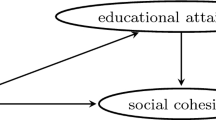Abstract
Graphical models based on conditional independence provide a concise representation of the subjective belief about the variables relationships of a single expert. Faced to the task of constructing a large model, we may find that each expert might be specialist in some subset of the complete domain. It may be desirable to aggregate the knowledge provided by those specialists, under the form of related graphical models, into a single more general representation. This paper introduces a new model for combining the graphs associated to two Bayesian networks into a single one, which may be used as consensus model.
Access this chapter
Tax calculation will be finalised at checkout
Purchases are for personal use only
Preview
Unable to display preview. Download preview PDF.
Similar content being viewed by others
References
Buntine, W. (1994) Operations for Learning with Graphical Models. Journal of Artificial Intelligence Research 8: 195–210.
Chikering, D.M. (1995) A transformational characterization of equivalent Bayesian network structures. In. Proceedings of the 11 th Conference on Uncertainty in Artificial Intelligence, 87–98.
Cooke, R.M. (1991) Experts Systems in Uncertainty: Opinion and Subjective Probability in Science. New York: Oxford University Press.
Genest, C., and Zidek, J.V. (1986) Combining probability distributions: A critique and an annotated bibliography. Statistical Science 1: 114–148.
Beckerman, D. (1995) A tutorial on learning Bayesian networks. Technical Report MSR-TR-95–06, Microsoft Research, Advanced Technology Division.
Jensen, F.V. (1996) An Introduction to Bayesian Networks. London: UCL Press.
Krause, P.J. (1998) Learning probabilistic networks. The knowledge Engineering Review 13: 321–351.
Matzkevich, I., and Abramson, B. (1992) The topological fusion of Bayes nets. In Proceedings of the 8 th Annual Conference on Uncertainty in Artificial Intelligence, 191–198.
Matzkevich, I., and Abramson, B. (1993) Some complexity considerations in the combination of belief networks. In Proceedings of the 9th Annual Conference on Uncertainty in Artificial Intelligence, 152–158.
Pearl, J. (1988) Probabilistic Reasoning in Intelligent Systems. San Mateo, CA: Morgan Kaufmann.
Pearl, J., and Paz, A. (1985) GRAPHOIDS: A graph-based logic for reasoning about relevance relations.
Technical Report 850038 (R-53-L),Cognitive Systems Laboratory, University of California, Los Angeles.
Pennock, D.M., and Wellman, M.P. (1999) Graphical representations of consensus belief. In Proceedings of the 15th Annual Conference on Uncertainty in Artificial Intelligence, 531–540.
Pennock, D.M. (1999) Aggregating probabilistic beliefs: market mechanisms and graphical representations. Ph D. Thesis, University of Michigan.
Verma, T., and Pearl, J. (1991) Equivalence and synthesis of causal models. In Uncertainty in Artificial Intelligence, 6, Amsterdam: Elsevier Science, 255–268.
Author information
Authors and Affiliations
Editor information
Editors and Affiliations
Rights and permissions
Copyright information
© 2001 Springer-Verlag Wien
About this chapter
Cite this chapter
del Sagrado, J., Moral, S. (2001). Qualitative Aggregation of Bayesian Networks. In: Della Riccia, G., Lenz, HJ., Kruse, R. (eds) Data Fusion and Perception. International Centre for Mechanical Sciences, vol 431. Springer, Vienna. https://doi.org/10.1007/978-3-7091-2580-9_5
Download citation
DOI: https://doi.org/10.1007/978-3-7091-2580-9_5
Publisher Name: Springer, Vienna
Print ISBN: 978-3-211-83683-5
Online ISBN: 978-3-7091-2580-9
eBook Packages: Springer Book Archive




